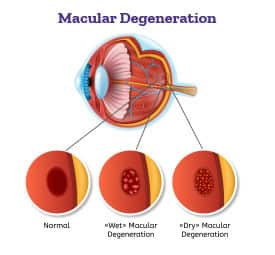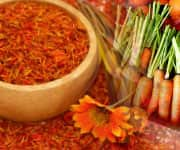Life Extension Magazine®
A major cause of blindness in the United States is macular degeneration.1
Up to 11 million Americans are afflicted with it.2
Scientists have identified plant pigments that accumulate in the eyes and protect macular density.3-5
Lutein, zeaxanthin, meso-zeaxanthin and astaxanthin can help protect against age-related macular degeneration.
People with the highest intake of lutein and zeaxanthin have a 41% lower risk of advanced macular degeneration.6
For people already afflicted, extracts of the spice saffron have been shown to improve visual function.7
One study in patients with early macular degeneration showed that 80% of those taking saffron daily for three months improved visual acuity on the Snellen eye chart (by one line) compared to baseline.8
An improvement by one line on the Snellen chart means someone whose visual acuity at a distance was 20/40 would be able to see with 20/30 vision after just three months of daily saffron use.
Several other compounds have been shown to help prevent and even partially restore the vision loss that occurs with age-related macular degeneration.
A Leading Cause of Blindness

Age-related macular degeneration is the leading cause of severe vision loss and blindness in people over age 60.9
Risk factors for age-related macular degeneration include:10
- Age
- Family history
- Genetics
- Tobacco use
- High blood pressure
- Cardiovascular disease
- Obesity
- Sun exposure
- Diet low in dark green leafy vegetables and omega-3 fatty acids
The progressive damage that occurs to the macula contributes to the characteristic gradual loss of central vision. Patients often complain that central vision becomes washed out, with a loss of detail. Straight lines may also appear wavy.10
Lutein and Zeaxanthin

Lutein and zeaxanthin are dietary carotenoids found in dark green leafy vegetables and colorful fruits.11
Within the body, they concentrate in several parts of the eye, including the macula.12-14
There, they absorb blue and ultraviolet light, preventing retina damage. They also quench free radicals, inhibiting their destructive impact on the cells of the retina.13-16
In one study of adults with age-related macular degeneration, taking 10 mg of lutein daily for one year increased macular pigment density by almost 40%, compared to baseline.17
Increased macular pigment ocular density means increased protection against ultraviolet and blue light.
Scientists demonstrated that 48 weeks of taking daily lutein alone or lutein combined with zeaxanthin produced significant increases in electroretinogram signals.18 This is a measure of the power of light-sensitive cells to produce electrical impulses after stimulation by light.19
In a series of large clinical studies, researchers documented that oral intake of lutein and/or zeaxanthin can:6,17,18,20-22
- Improve retinal function,
- Increase the ability to see contrasting colors and shapes, and
- Improve visual acuity (the ability to see sharply at a distance).
One study of over 102,000 people aged 50 and older took more than 20 years to complete.
It found that those with the highest intake of lutein and zeaxanthin had a remarkable 41% lower risk of advanced macular degeneration.6
Meso-Zeaxanthin
Meso-zeaxanthin is a yellow carotenoid derived from lutein. It is known to be produced in the eye itself, and a small amount may occur in certain foods.23
Individuals with macular degeneration have 30% less meso-zeaxanthin in their macula than those with good eye health.24
One reason for this deficiency of meso-zeaxanthin is lack of ingested lutein. Another explanation for the missing meso-zeaxanthin observed in macular degeneration is inability to adequately convert lutein to meso-zeaxanthin.
Meso-zeaxanthin, when taken orally, increases protective macular pigment levels.25
Astaxanthin

Astaxanthin is a reddish carotenoid found in marine algae and some seafood.26,27
In preclinical studies, it protects the cells of the retina from being damaged by physical and oxidative stress.26-28
For example, astaxanthin may protect eye cells from UV-induced, free-radical damage by suppressing activation of an inflammatory protein, nuclear factor-kappa B (NF-kB).29
In experimental studies, astaxanthin prevented the vision-damaging effects of wet macular degeneration that occurs when blood vessels leak fluid into the retina. One rodent study showed it prevented cell damage related to increased pressure in the eye, which is the underlying problem in glaucoma.30
Astaxanthin’s eye-protecting ability may be especially beneficial for people with diabetes.
Diabetic retinopathy occurs when high levels of blood sugar damage the retina over time, leading to vision problems. Among those who have had diabetes for over a decade, 80% suffer from this condition.26
In animal studies, astaxanthin targets the retina and prevents the early nerve-cell death that is caused by excess blood sugar.26
Research has found that 6 mg of astaxanthin daily helped promote visual sharpness and eye health.31
What you need to know
Powerful Protection for the Eyes
- Age-related vision loss is extremely common and may lead to eventual blindness.
- Lutein, zeaxanthin, meso-zeaxanthin, astaxanthin, saffron, and alpha-carotene have been identified as key nutrients that can protect the eyes and slow the progression of age-related macular degeneration.
- Cyanidin-3-glucoside, found in certain dark berries, enhances night vision.
Saffron

Clinical studies demonstrate that saffron, a spice derived from the crocus flower, improves various visual functions.32
Saffron has been studied for an array of neuro-degenerative eye diseases, including:33,34
- Age-related macular degeneration, and
- Diabetic retinopathy.
Saffron may provide these benefits thanks to its anti-inflammatory, antioxidant, and neuroprotective properties, along with its ability to help prevent cell death.35
In one clinical study, 20 mg of saffron enhanced visual function in patients with mild to moderate age-related macular degeneration, including those already taking lutein and zeaxanthin.
Compared to those taking a placebo, participants who took saffron alone improved on a standard vision-measuring eye chart by .69 letters. Those already taking lutein or zeaxanthin improved by .73 letters.7
In another study, 20 mg of saffron daily improved the light-sensing abilities of retinal cells for patients with early age-related macular degeneration. After three months, these subjects were able to read one entire additional line on an eye chart, while those taking a placebo did not improve.8
This means that someone whose visual acuity at a distance was 20/40 would be able to see with 20/30 vision after just three months of saffron use.
To test longer-term benefits, scientists gave 20 mg of saffron daily to patients with early macular degeneration for an average of 14 months. Retinal sensitivity was improved for the entire period, and average visual acuity improved by an astounding two lines on an eye chart.36
This showed that longer saffron use produces greater improvement.36
Alpha-Carotene
Alpha-carotene, a carotenoid and vitamin A precursor found in pumpkins and carrots, protects retinal cells from light-induced oxidative damage.
One study analyzed 63,443 women and 38,603 men, aged 50 and older. It found that those with the highest dietary intake of alpha-carotene had a 31% reduced risk of developing advanced age-related macular degeneration, compared to those with the lowest consumption.6
This yellow-orange carotenoid has even been shown to provide protection for smokers.
In one study of 1,414 men aged 65 and over, smokers with the highest alpha-carotene intake were found to have a significantly reduced risk of developing age-related macular degeneration.37
Cyanidin-3-Glucoside

Cyanidin-3-glucoside (C3G) is a flavonoid found in many dark-colored berries.38,39
Recent research on human cells suggests that cyanidin-3-glucoside may protect epithelial (surface) cells in the cornea (the eye’s protective outer layer) against damaging effects of bacterial activity and inflammation.40
C3G may also reduce oxidative damage from light and free radicals in retinal pigment epithelium cells.41
While these investigations are preliminary, cyanidin-3-glucoside may offer support to macular degeneration patients.
Many of these afflicted individuals experience difficulties when performing activities at night and under low light, such as driving or reading at night.42
The retina’s rod cells are the eye’s most sensitive cells, allowing us to see in very dim light. Loss of rod cells is associated with night blindness or reduced vision in low light.43
Cyanidin-3-glucoside has been shown to enhance the quality and function of rhodopsin, a light-sensitive protein found in the rod cells of the retina. It also boosts the ability of rhodopsin to regenerate.39,44-46
One study of healthy volunteers showed that a berry extract containing cyanidin-3-glucoside improved night vision, allowing aging individuals to see better in darkness. This improvement was noticeable after just 30 minutes.47
Taken in combination, C3G and other eye-protecting nutrients may provide the most complete range of benefits for preventing age-related vision loss.
Summary

Loss of visual acuity and night blindness are major threats to aging adults.
Extensive evidence demonstrates that the carotenoids lutein, zeaxanthin, meso-zeaxanthin, and astaxanthin protect the eye and help prevent vision loss as a result of macular degeneration, and possibly other conditions as well.
In addition, the spice saffron protects against early macular degeneration, while alpha-carotene helps protect against advanced macular degeneration.
The flavonoid cyanidin-3-glucoside can enhance night vision in as little as 30 minutes.
In combination, these seven nutrients can provide comprehensive vision protection.
If you have any questions on the scientific content of this article, please call a Life Extension® Wellness Specialist at 1-866-864-3027.
References
- Available at: https://www.cdc.gov/visionhealth/basics/ced/index.html. Accessed June 30, 2021.
- Available at: https://www.brightfocus.org/macular/article/age-related-macular-facts-figures. Accessed June 29, 2021.
- Huynh TP, Mann SN, Mandal NA. Botanical compounds: effects on major eye diseases. Evid Based Complement Alternat Med. 2013;2013:549174.
- Widomska J, Subczynski WK. Why has Nature Chosen Lutein and Zeaxanthin to Protect the Retina? J Clin Exp Ophthalmol. 2014 Feb 21;5(1):326.
- Piermarocchi S, Saviano S, Parisi V, et al. Carotenoids in Age-related Maculopathy Italian Study (CARMIS): two-year results of a randomized study. Eur J Ophthalmol. 2012 Mar-Apr;22(2):216-25.
- Wu J, Cho E, Willett WC, et al. Intakes of Lutein, Zeaxanthin, and Other Carotenoids and Age-Related Macular Degeneration During 2 Decades of Prospective Follow-up. JAMA Ophthalmol. 2015 Dec;133(12):1415-24.
- Broadhead GK, Grigg JR, McCluskey P, et al. Saffron therapy for the treatment of mild/moderate age-related macular degeneration: a randomised clinical trial. Graefes Arch Clin Exp Ophthalmol. 2019 Jan;257(1):31-40.
- Falsini B, Piccardi M, Minnella A, et al. Influence of saffron supplementation on retinal flicker sensitivity in early age-related macular degeneration. Invest Ophthalmol Vis Sci. 2010 Dec;51(12):6118-24.
- Available at: https://www.webmd.com/eye-health/macular-degeneration/age-related-macular-degeneration-overview#1. Accessed June 28, 2021.
- Available at: https://www.merckmanuals.com/home/eye-disorders/retinal-disorders/age-related-macular-degeneration-amd-or-armd. Accessed June 29, 2021.
- Jia YP, Sun L, Yu HS, et al. The Pharmacological Effects of Lutein and Zeaxanthin on Visual Disorders and Cognition Diseases. Molecules. 2017 Apr 20;22(4):610.
- Rasmussen HM, Johnson EJ. Nutrients for the aging eye. Clin Interv Aging. 2013;8:741-8.
- Ma L, Lin XM. Effects of lutein and zeaxanthin on aspects of eye health. J Sci Food Agric. 2010 Jan 15;90(1):2-12.
- Roberts JE, Dennison J. The Photobiology of Lutein and Zeaxanthin in the Eye. J Ophthalmol. 2015;2015:687173.
- Aimjongjun S, Sutheerawattananonda M, Limpeanchob N. Silk lutein extract and its combination with vitamin E reduce UVB-mediated oxidative damage to retinal pigment epithelial cells. J Photochem Photobiol B. 2013 Jul 5;124:34-41.
- Pongcharoen S, Warnnissorn P, Lertkajornsin O, et al. Protective effect of silk lutein on ultraviolet B-irradiated human keratinocytes. Biol Res. 2013;46(1):39-45.
- Murray IJ, Makridaki M, van der Veen RL, et al. Lutein supplementation over a one-year period in early AMD might have a mild beneficial effect on visual acuity: the CLEAR study. Invest Ophthalmol Vis Sci. 2013 Mar 11;54(3):1781-8.
- Ma L, Dou HL, Huang YM, et al. Improvement of retinal function in early age-related macular degeneration after lutein and zeaxanthin supplementation: a randomized, double-masked, placebo-controlled trial. Am J Ophthalmol. 2012 Oct;154(4):625-34 e1.
- Available at: https://www.medicinenet.com/electroretinography/article.htm. Accessed June 29, 2021.
- Ma L, Yan SF, Huang YM, et al. Effect of lutein and zeaxanthin on macular pigment and visual function in patients with early age-related macular degeneration. Ophthalmology. 2012 Nov;119(11):2290-7.
- Richer S, Stiles W, Statkute L, et al. Double-masked, placebo-controlled, randomized trial of lutein and antioxidant supplementation in the intervention of atrophic age-related macular degeneration: the Veterans LAST study (Lutein Antioxidant Supplementation Trial). Optometry. 2004 Apr;75(4):216-30.
- Weigert G, Kaya S, Pemp B, et al. Effects of lutein supplementation on macular pigment optical density and visual acuity in patients with age-related macular degeneration. Invest Ophthalmol Vis Sci. 2011 Oct 17;52(11):8174-8.
- Nolan JM, Meagher K, Kashani S, et al. What is meso-zeaxanthin, and where does it come from? Eye (Lond). 2013 Aug;27(8):899-905.
- Available at: https://patents.google.com/patent/US6329432B2/en. Accessed June 29, 2021.
- Bone RA, Landrum JT, Cao Y, et al. Macular pigment response to a supplement containing meso-zeaxanthin, lutein and zeaxanthin. Nutr Metab (Lond). 2007 May 11;4:12.
- Dong LY, Jin J, Lu G, et al. Astaxanthin attenuates the apoptosis of retinal ganglion cells in db/db mice by inhibition of oxidative stress. Mar Drugs. 2013 Mar 21;11(3):960-74.
- Izumi-Nagai K, Nagai N, Ohgami K, et al. Inhibition of choroidal neovascularization with an anti-inflammatory carotenoid astaxanthin. Invest Ophthalmol Vis Sci. 2008 Apr;49(4):1679-85.
- Li Z, Dong X, Liu H, et al. Astaxanthin protects ARPE-19 cells from oxidative stress via upregulation of Nrf2-regulated phase II enzymes through activation of PI3K/Akt. Mol Vis. 2013;19:1656-66.
- Lennikov A, Kitaichi N, Fukase R, et al. Amelioration of ultraviolet-induced photokeratitis in mice treated with astaxanthin eye drops. Mol Vis. 2012;18:455-64.
- Cort A, Ozturk N, Akpinar D, et al. Suppressive effect of astaxanthin on retinal injury induced by elevated intraocular pressure. Regul Toxicol Pharmacol. 2010 Oct;58(1):121-30.
- Kidd P. Astaxanthin, cell membrane nutrient with diverse clinical benefits and anti-aging potential. Altern Med Rev. 2011 Dec;16(4):355-64.
- Bosch-Morell F, Villagrasa V, Ortega T, et al. Medicinal plants and natural products as neuroprotective agents in age-related macular degeneration. Neural Regen Res. 2020 Dec;15(12):2207-16.
- Fernandez-Albarral JA, de Hoz R, Ramirez AI, et al. Beneficial effects of saffron (Crocus sativus L.) in ocular pathologies, particularly neurodegenerative retinal diseases. Neural Regen Res. 2020 Aug;15(8):1408-16.
- Sepahi S, Mohajeri SA, Hosseini SM, et al. Effects of Crocin on Diabetic Maculopathy: A Placebo-Controlled Randomized Clinical Trial. Am J Ophthalmol. 2018 Jun;190:89-98.
- Heitmar R, Brown J, Kyrou I. Saffron (Crocus sativus L.) in Ocular Diseases: A Narrative Review of the Existing Evidence from Clinical Studies. Nutrients. 2019 Mar 18;11(3).
- Piccardi M, Marangoni D, Minnella AM, et al. A longitudinal follow-up study of saffron supplementation in early age-related macular degeneration: sustained benefits to central retinal function. Evid Based Complement Alternat Med. 2012;2012:429124.
- Kim EK, Kim H, Vijayakumar A, et al. Associations between fruit and vegetable, and antioxidant nutrient intake and age-related macular degeneration by smoking status in elderly Korean men. Nutr J. 2017 Dec 4;16(1):77.
- Tremblay F, Waterhouse J, Nason J, et al. Prophylactic neuroprotection by blueberry-enriched diet in a rat model of light-induced retinopathy. J Nutr Biochem. 2013 Apr;24(4):647-55.
- Lee SH, Jeong E, Paik SS, et al. Cyanidin-3-glucoside extracted from mulberry fruit can reduce N-methyl-N-nitrosourea-induced retinal degeneration in rats. Curr Eye Res. 2014 Jan;39(1):79-87.
- Li X, Sun M, Long Y. Cyanidin-3-O-Glucoside Attenuates Lipopolysaccharide-Induced Inflammation in Human Corneal Epithelial Cells by Inducing Let-7b-5p-Mediated HMGA2/PI3K/Akt Pathway. Inflammation. 2020 Jun;43(3):1088-96.
- Pawlowska E, Szczepanska J, Koskela A, et al. Dietary Polyphenols in Age-Related Macular Degeneration: Protection against Oxidative Stress and Beyond. Oxid Med Cell Longev. 2019;2019:9682318.
- Ying GS, Maguire MG, Liu C, et al. Night vision symptoms and progression of age-related macular degeneration in the Complications of Age-related Macular Degeneration Prevention Trial. Ophthalmology. 2008 Nov;115(11):1876-82.
- Available at: https://www.ncbi.nlm.nih.gov/books/NBK10850/. Accessed June 29, 2021.
- Matsumoto H, Nakamura Y, Tachibanaki S, et al. Stimulatory effect of cyanidin 3-glycosides on the regeneration of rhodopsin. J Agric Food Chem. 2003 Jun 4;51(12):3560-3.
- Tirupula KC, Balem F, Yanamala N, et al. pH-dependent interaction of rhodopsin with cyanidin-3-glucoside. 2. Functional aspects. Photochem Photobiol. 2009 Mar-Apr;85(2):463-70.
- Yanamala N, Tirupula KC, Balem F, et al. pH-dependent interaction of rhodopsin with cyanidin-3-glucoside. 1. Structural aspects. Photochem Photobiol. 2009 Mar-Apr;85(2):454-62.
- Nakaishi H, Matsumoto H, Tominaga S, et al. Effects of black current anthocyanoside intake on dark adaptation and VDT work-induced transient refractive alteration in healthy humans. Altern Med Rev. 2000 Dec;5(6):553-62.

